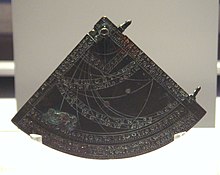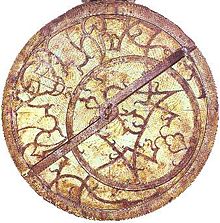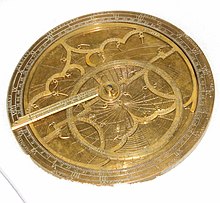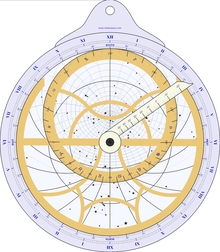Astrolabe


An astrolabe ([ἀστρολάβον astrolabon, "star-taker"] Error: {{Lang-xx}}: text has italic markup (help))[1] is an elaborate inclinometer, historically used by astronomers, navigators, and astrologers. Its many uses include locating and predicting the positions of the Sun, Moon, planets, and stars, determining local time given local latitude and vice-versa, surveying, triangulation, and to cast horoscopes. It was used in classical antiquity, through the Islamic Golden Age, the European Middle Ages and Renaissance for all these purposes. In the Islamic world, it was also used to calculate the Qibla and to find the times for Salah, prayers.
There is often confusion between the astrolabe and the mariner's astrolabe. While the astrolabe could be useful for determining latitude on land, it was an awkward instrument for use on the heaving deck of a ship or in wind. The mariner's astrolabe was developed to address these issues.
Etymology
OED gives the translation "star-taker" for the English word "astrolabe" and traces it, through medieval Latin, to a Greek word astrolabon.[1] In the medieval Islamic world the word "asturlab" (i.e. astrolabe) was given various etymologies. In Arabic texts the word is translated as "akhdh al-kawakib" (lit. "taking the stars") which corresponds to an interpretation of the Greek word [2]. al-Biruni quotes and criticizes the medieval scientist Hamza al-Isfahani who had stated [3] " asturlab is an arabization of this Persian phrase" : sitara yab meaning "taker of the stars" [4] In medieval Islamic sources there is also a "fictional" and popular etymology of the words as "lines of lab". In this popular etymology "Lab" is a certain son of Idris (=Enoch). This etymology is mentioned by a 10th-century scientist called al-Qummi but rejected by al-Khwarizmi [5].
the astocrap is not a ggod tool. he id fat i do not likey him at all. a math id g9ood. i rule
Construction


An astrolabe consists of a disk, called the mater (mother), which is deep enough to hold one or more flat plates called tympans, or climates. A tympan is made for a specific latitude and is engraved with a stereographic projection of circles denoting azimuth and altitude and representing the portion of the celestial sphere above the local horizon. The rim of the mater is typically graduated into hours of time, degrees of arc, or both. Above the mater and tympan, the rete, a framework bearing a projection of the ecliptic plane and several pointers indicating the positions of the brightest stars, is free to rotate. Some astrolabes have a narrow rule or label which rotates over the rete, and may be marked with a scale of declinations.
The rete, representing the sky, functions as a star chart. When it is rotated, the stars and the ecliptic move over the projection of the coordinates on the tympan. One complete rotation corresponds to the passage of a day. The astrolabe is therefore a predecessor of the modern planisphere.
On the back of the mater there is often engraved a number of scales that are useful in the astrolabe's various applications; these vary from designer to designer, but might include curves for time conversions, a calendar for converting the day of the month to the sun's position on the ecliptic, trigonometric scales, and a graduation of 360 degrees around the back edge. The alidade is attached to the back face. An alidade can be seen in the lower right illustration of the Persian astrolabe above. When the astrolabe is held vertically, the alidade can be rotated and the sun or a star sighted along its length, so that its altitude in degrees can be read ("taken") from the graduated edge of the astrolabe; hence the word's Greek roots: "astron" (ἄστρον) = star + "lab-" (λαβ-) = to take.
See also
- Antikythera mechanism
- Armillary sphere
- Astrarium
- Astronomical clock
- Cosmolabe
- Equatorium
- Islamic astronomy
- Orrery
- Philippe Danfrie, designer and maker of mathematical instruments, globes and astrolabes
- Planetarium
- Planisphere
- Prague Orloj
- Sextant (astronomical)
- Sharafeddin Tusi, the inventor of the linear astrolabe
- Torquetum
- Canterbury Astrolabe Quadrant
- Hypatia
- Marshall Islands stick chart
Notes
- ^ a b astrolabe, Oxford English Dictionary 2nd ed. 1989
- ^ King (1981:44)
- ^ King (1981:44)
- ^ King (1981:51)
- ^ King (1981:45)
References
- Evans, James (1998), The History and Practice of Ancient Astronomy, Oxford University Press, ISBN 0195095391.
- Alessandro Gunella and John Lamprey, Stoeffler's Elucidatio (translation of Elucidatio fabricae ususque astrolabii into English). Published by John Lamprey, 2007.
- Krebs, Robert E.; Krebs, Carolyn A. (2003), Groundbreaking Scientific Experiments, Inventions, and Discoveries of the Ancient World, Greenwood Press.
- Edgar Laird. "Astrolabes and the Construction of Time in the Late Middle Ages." In: Constructions of Time in the Late Middle Ages. Ed. Carol Poster and Richard Utz. Evanston, IL: Northwestern University Press, 1997, pp. 51–69.
- King, D. A (1981), "The Origin of the Astrolabe According to the Medieval Islamic Sources", Journal for the History of Arabic Science, 5: 43–83
- Lewis, M. J. T. (2001), Surveying Instruments of Greece and Rome, Cambridge University Press.
- Morrison, James E (2007), The Astrolabe, Janus, ISBN 9780939320301.
- John North. God's Clockmaker, Richard of Wallingford and the invention of time. Hambledon and London, 2006.
- Critical edition of Pelerin de Prusse on the Astrolabe (translation of Practique de Astralabe). Editors Edgar Laird, Robert Fischer. Binghamton, New York, 1995, in Medieval & Renaissance Texts & Studies. ISBN 0-86698-132-2
- King, Henry Geared to the Stars: the evolution of planetariums, orreries, and astronomical clocks University of Toronto Press, 1978
External links
- paper astrolabe generator, from the ESA
- "Hello World!" for the Astrolabe: The First Computer Video of Howard Covitz's Presentation at Ignite Phoenix, June 2009. Slides for Presentation Licensed as Creative Commons by-nc-nd.
- Video of Tom Wujec demonstrating an astrolabe. Taken at TEDGlobal 2009. Includes clickable transcript. Licensed as Creative Commons by-nc-nd.
- The Astrolabe
- A working model of the Dr. Ludwig Oechslin's Astrolabium Galileo Galilei watch
- Ulysse Nardin Astrolabium Galilei Galileo: A Detailed Explanation
- Fully illustrated online catalogue of world's largest collection of astrolabes
- Gerbert d'Aurillac's use of the Astrolabe at Convergence
- Mobile astrolabe and horologium
- medieval equal hour horary quadrant
